恶性淋巴瘤疗效评价标准
恶性淋巴瘤疗效评价的修订标准

J OURNAL OF C LINICAL O NCOLOGY恶性淋巴瘤疗效评价的修订标准Bruce D. Cheson, Beate Pfistner, Malik E. Juweid, Randy D. Gascoyne, Lena Specht, Sandra J. Horning, Bertrand Coiffier, Richard I. Fisher, Anton Hagenbeek, Emanuele Zucca, Steven T. Rosen, Sigrid Stroobants, T. Andrew Lister, Richard T. Hoppe, Martin Dreyling, Kensei Tobinai, Julie M. Vose, Joseph M. Connors, Massimo Federico, and Volker Diehl摘 要目的有必要制定规范的疗效标准以用于各个临床试验的解释和对照,以及管理机构对治疗新药的审批。
方法国际工作组疗效标准(Cheson et al, J Clin Oncol 17:1244, 1999)一直被广泛采用,但由于其明显的局限性以及[18F]脱氧葡萄糖正电子发射断层成像(PET )、免疫组化(IHC )与流式细胞学技术的推广应用,需要重新评估该标准。
因此,开展国际性协调议案以进行建议的更新。
结果新指南将PET 、IHC 和流式细胞学技术纳入非霍奇金与霍奇金淋巴瘤的疗效评估。
同时规范了终点的定义。
结论希望这些指南得到各研究组、制药和生物技术公司的广泛采纳,并有助于管理机构对新药和更有效治疗方法的审批,由此改善淋巴瘤患者的预后。
J Clin Oncol 25:579-586. © 2007 by American Society of Clinical Oncology规范的疗效标准为临床试验提供了统一的终点,这使得各研究间具有可比性,有助于明确更有效的治疗方法和管理机构对新药的审批。
肿瘤治疗疗效评价标准

肿瘤治疗疗效评价标准一、肿瘤大小变化1.完全缓解(CR):所有目标病灶消失,无新病灶出现,肿瘤标志物正常。
2.部分缓解(PR):目标病灶体积减小,至少缩小50%,且无新病灶出现,肿瘤标志物正常。
3.稳定(SD):目标病灶体积无变化或缩小不足50%,且无新病灶出现,肿瘤标志物正常。
4.进展(PD):目标病灶体积增大,或出现新病灶,或肿瘤标志物异常。
二、生存期延长生存期是指从开始治疗到死亡的时间。
评价生存期延长的标准可采用总生存期(OS)和无病生存期(DFS)等指标。
OS是指从开始治疗到死亡的时间,DFS是指从开始治疗到疾病复发或进展的时间。
三、症状改善1.完全缓解(CR):所有症状完全消失,且持续时间超过2周。
2.部分缓解(PR):症状明显减轻,且持续时间超过2周。
3.稳定(SD):症状无变化或略有减轻,但未达到PR标准。
4.进展(PD):症状加重或出现新症状。
四、血液学指标血液学指标主要包括血常规、肝肾功能等。
在治疗前后进行血液学检查,以评估患者的一般状况和不良反应情况。
对于某些特定类型的肿瘤,血液学指标也可作为疗效评价的参考。
五、病理学改变对于某些肿瘤,病理学改变是疗效评价的重要指标。
例如,对于淋巴瘤等血液系统肿瘤,病理学改变包括肿瘤细胞坏死、细胞凋亡等反应。
可根据病理学检查的结果进行疗效评价。
六、安全性评估安全性评估是评价抗肿瘤治疗的另一个重要方面。
它包括对治疗过程中出现的所有不良反应进行记录和评估。
不良反应可根据NCI-CTCA E 等标准进行分级和评估。
安全性评估有助于及时发现和治疗不良反应,提高患者的生活质量和生存期。
七、生活质量评估生活质量评估是抗肿瘤治疗疗效评价的另一个重要方面。
它包括对患者的身体状况、心理状况、社会功能等方面进行全面的评估。
生活质量评估有助于了解患者的生活质量状况和抗肿瘤治疗对患者的影响程度,为制定更加全面的治疗方案提供参考。
2019年恶性淋巴瘤疗效评价标准-PPT课件

Use of Positron Emission Tomography for Response Assessment of Lymphoma: Consensus of the Imaging Subcommittee of International Harmonization Project in Lymphoma
• Allowing for comparisons among studies
• Facilitating the identification of more effective therapies
The widely used IWG criteria for response assessment of lymphoma are based predominantly on CT.
It became clear that the International Working Group criteria warranted revision, because of identified limitations and the increased use of :
1. [18F] fluorodeoxyglucose-positron emission tomography (PET), 2. immunohistochemistry (IHC), 3. flow cytometry, 4. molecular biology
“REVISED RESPONSE CRITERIA FOR MALIGNANT LYMPHOMA”
淋巴瘤疗效评价标准

淋巴瘤疗效评价标准
淋巴瘤是一种常见的恶性肿瘤,由淋巴细胞恶性增殖引起。
在淋巴瘤的治疗过程中,评价疗效是非常重要的,可以帮助医生更好地调整治疗方案,提高患者的治疗效果。
淋巴瘤的疗效评价标准是根据患者的临床表现、影像学检查和实验室检查等综合评定的。
下面将介绍淋巴瘤疗效评价的标准及其相关内容。
一、临床表现。
1. 症状改善,包括发热、盗汗、体重减轻、淋巴结肿大等症状的减轻或消失。
2. 肿瘤负荷减轻,淋巴瘤患者的肿瘤负荷可以通过体格检查和淋巴结活检等手段来评价,肿瘤负荷的减轻通常意味着治疗效果好。
二、影像学检查。
1. CT或MRI检查,通过CT或MRI检查可以观察淋巴瘤病灶的大小、数量和分布情况,评估治疗效果。
2. PET-CT检查,PET-CT检查可以更准确地评估淋巴瘤病灶的活动情况,对疗效评价具有重要意义。
三、实验室检查。
1. 血液学检查,包括血常规、肝肾功能、电解质等指标,可以反映淋巴瘤患者的整体健康状况和治疗效果。
2. 淋巴细胞亚群分析,淋巴瘤患者的淋巴细胞亚群分析可以帮助评估免疫功能和疾病活动情况。
综上所述,淋巴瘤的疗效评价需要综合临床表现、影像学检查和实验室检查等多方面的信息。
在评价疗效时,需要注意病情的动态变化,及时调整治疗方案,以
提高治疗效果。
同时,淋巴瘤的疗效评价标准也在不断发展和完善中,希望未来可以有更准确、可靠的评价指标,为淋巴瘤患者提供更好的治疗和管理。
2007年恶性淋巴瘤疗效评价标准电子教案
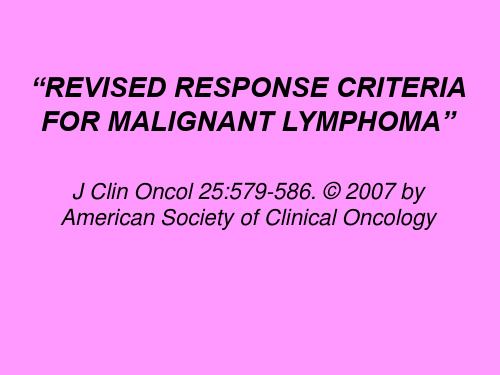
PET
• False-positive: - Thymic hyperplasia - Infection - Inflammation - Sarcoidosis - Brown fat Other causes of false-positive scans should be ruled out.
Whole-body acquisition using a PET or PET/CT system should encompass at least the region between the base of the skull and themed thigh, and can be acquired in either two- or three-dimensional mode.
Whole-body imaging should begin 50-70 minutes after the administration of FDG.
The reconstructed PET or PET/CT images must be displayed on a computer workstation so that transaxial, sagittal, and coronal images can be viewed simultaneously.
皮肤淋巴瘤疗效评价标准2023

皮肤淋巴瘤是一种罕见的非霍奇金淋巴瘤,通常发生在皮肤和表皮下组织。
由于其症状多样化,治疗方法也多种多样,因此对其疗效的评价标准显得尤为重要。
本文将从多个角度来探讨皮肤淋巴瘤疗效评价标准,并对2023年的相关标准进行深入分析。
1. 临床表现评价皮肤淋巴瘤的临床表现多样,包括皮肤色素沉着、斑块、结节、溃疡等症状。
评价疗效时需要综合考虑病变部位、大小、颜色、形态等因素,以及患者的主观感受,对病变的缓解程度进行评价。
2. 影像学检查评价影像学检查对于评估皮肤淋巴瘤的疗效至关重要。
通常采用超声检查、CT、MRI等技术来观察病变的范围、深度、浸润情况等,从而判断治疗的效果。
3. 病理学检查评价病理学检查是确诊皮肤淋巴瘤的关键。
在评价疗效时,可以通过活检等方式获取组织样本,观察治疗后病变的缓解程度、组织的恢复情况等。
4. 免疫学指标评价免疫学指标在评价皮肤淋巴瘤的疗效中起着重要作用。
对于免疫功能的恢复、炎症因子的水平、肿瘤标志物等进行监测和评价,可以更加客观地了解治疗的效果。
5. 患者生活质量评价治疗的最终目的是改善患者的生活质量。
在评价皮肤淋巴瘤的疗效时,需要考虑患者的生活状态、心理状态、社会功能等方面,通过问卷调查、心理评估等方式进行客观评价。
2023年的皮肤淋巴瘤疗效评价标准应该更加科学、客观、全面。
具体来说,可以考虑以下几个方面的改进:1. 引入新技术随着医学技术的不断进步,可以引入更先进的影像学技术、病理学检查技术、免疫学指标监测技术等,以提高对皮肤淋巴瘤疗效的评价水平。
2. 建立标准化评价体系制定统一的评价指标和评分标准,使得皮肤淋巴瘤的疗效评价更具客观性和标准化,不同医院、不同医生之间的评价结果更具可比性。
3. 结合患者主观感受在评价疗效时,应该更加注重患者的主观感受,比如疼痛程度、舒适度、生活质量等方面,为医生提供更全面的信息,从而更好地指导治疗方案的调整。
4. 加强随访管理对于皮肤淋巴瘤患者,应该建立健全的随访管理制度,对治疗效果进行长期跟踪,从而能更加客观地评价治疗的效果。
2019年恶性淋巴瘤疗效评价标准精品文档
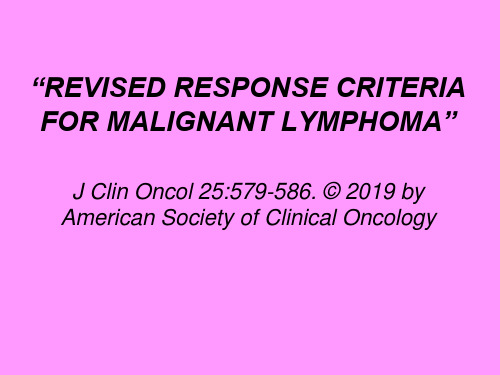
Response duration CR, CRu, PR
Time to next treatment
All patients
Cause-specific death All patients
Definition Death from any cause
Point of Measurement
Entry onto trial
It became clear that the International Working Group criteria warranted revision, because of identified limitations and the increased use of :
1. [18F] fluorodeoxyglucose-positron emission tomography (PET),
A recently developed integrated PET/CT system, which combines a PET camera and CT scanner in a single session, has overcome these drawbacks by providing both anatomical and functional imaging at the same position. PET/CT has become the new standard approach to imaging in the diagnosis and management of many cancer patients.
“REVISED RESPONSE CRITERIA FOR MALIGNANT LYMPHOMA”
淋巴瘤疗效评估标准
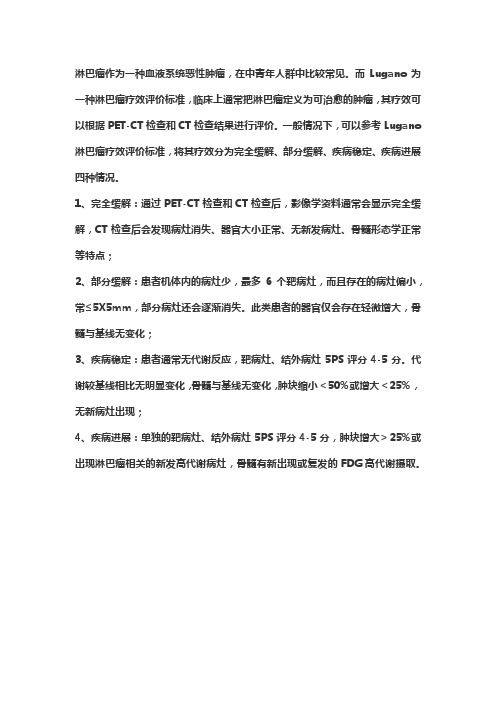
淋巴瘤作为一种血液系统恶性肿瘤,在中青年人群中比较常见。
而Lugano为一种淋巴瘤疗效评价标准,临床上通常把淋巴瘤定义为可治愈的肿瘤,其疗效可以根据PET-CT检查和CT检查结果进行评价。
一般情况下,可以参考Lugano 淋巴瘤疗效评价标准,将其疗效分为完全缓解、部分缓解、疾病稳定、疾病进展四种情况。
1、完全缓解:通过PET-CT检查和CT检查后,影像学资料通常会显示完全缓解,CT检查后会发现病灶消失、器官大小正常、无新发病灶、骨髓形态学正常等特点;
2、部分缓解:患者机体内的病灶少,最多6个靶病灶,而且存在的病灶偏小,常≤5X5mm,部分病灶还会逐渐消失。
此类患者的器官仅会存在轻微增大,骨髓与基线无变化;
3、疾病稳定:患者通常无代谢反应,靶病灶、结外病灶5PS评分4-5分。
代谢较基线相比无明显变化,骨髓与基线无变化,肿块缩小<50%或增大<25%,无新病灶出现;
4、疾病进展:单独的靶病灶、结外病灶5PS评分4-5分,肿块增大>25%或出现淋巴瘤相关的新发高代谢病灶,骨髓有新出现或复发的FDG高代谢摄取。
实体肿瘤疗效评估标准
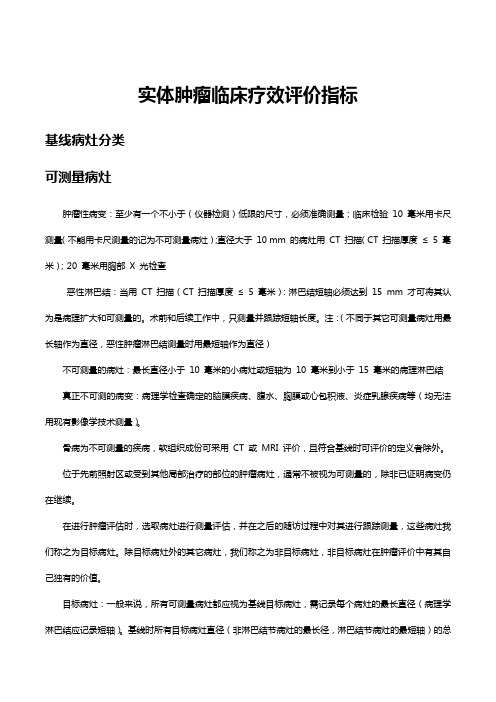
实体肿瘤临床疗效评价指标基线病灶分类可测量病灶肿瘤性病变:至少有一个不小于(仪器检测)低限的尺寸,必须准确测量;临床检验10 毫米用卡尺测量(不能用卡尺测量的记为不可测量病灶);直径大于10 mm 的病灶用CT 扫描(CT 扫描厚度≤5 毫米);20 毫米用胸部X 光检查恶性淋巴结:当用CT 扫描(CT 扫描厚度≤5 毫米):淋巴结短轴必须达到15 mm 才可将其认为是病理扩大和可测量的。
术前和后续工作中,只测量并跟踪短轴长度。
注:(不同于其它可测量病灶用最长轴作为直径,恶性肿瘤淋巴结测量时用最短轴作为直径)不可测量的病灶:最长直径小于10 毫米的小病灶或短轴为10 毫米到小于15 毫米的病理淋巴结真正不可测的病变:病理学检查确定的脑膜疾病、腹水、胸膜或心包积液、炎症乳腺疾病等(均无法用现有影像学技术测量)。
骨病为不可测量的疾病,软组织成份可采用CT 或MRI 评价,且符合基线时可评价的定义者除外。
位于先前照射区或受到其他局部治疗的部位的肿瘤病灶,通常不被视为可测量的,除非已证明病变仍在继续。
在进行肿瘤评估时,选取病灶进行测量评估,并在之后的随访过程中对其进行跟踪测量,这些病灶我们称之为目标病灶。
除目标病灶外的其它病灶,我们称之为非目标病灶,非目标病灶在肿瘤评价中有其自己独有的价值。
目标病灶:一般来说,所有可测量病灶都应视为基线目标病灶,需记录每个病灶的最长直径(病理学淋巴结应记录短轴)。
基线时所有目标病灶直径(非淋巴结节病灶的最长径,淋巴结节病灶的最短轴)的总和是试验中进行的评价比较的基础。
若两个病灶融合,就测量融合的肿块;若目标病灶分裂,则使用各部分的总和。
应继续记录变小的目标病灶的测量。
目标病灶变的太小而不能测量,如认为病灶已消失则记录为0 mm;反之应记录为默认值5 mm。
淋巴结缩小至<10 mm(正常),仍应记录实际测量结果。
非目标病灶:所有不可测量的疾病均为非目标病灶病灶。
所有未鉴别为目标病灶的可测量病灶也纳入非病灶疾病。
淋巴瘤评分标准及分期

胃肠道淋巴瘤分期标准Musshoff分期Ⅰ期肿瘤局限于胃肠道在横膈一侧,无淋巴结转移.Ⅰ1病变局限预黏膜层和黏膜下层Ⅰ2病变累及肌层、浆膜及浆膜下Ⅱ期肿瘤从病变部位侵及腹腔.淋巴结受累Ⅱ1引流区淋巴结转移(胃旁淋巴结)Ⅱ2远处淋巴结转移(肠系膜、腹主动脉旁、腔静脉旁或腹股沟等膈下淋巴结) ⅡE病变穿透浆膜累及邻近器官或组织.Ⅲ期肿瘤局限于胃肠道有/或横膈两侧淋巴结转移。
Ⅳ期肿瘤巨大,伴有或不伴有淋巴结转移和弥漫性非胃肠道器官或组织累及.An Arbor分期标准:Ⅰ侵及一个淋巴结区或一个结外器官或部位Ⅱ横隔一侧,侵及两个或更多个的淋巴结区或外加局限侵犯一个结外器官或部位Ⅲ侵犯横隔两侧淋巴结区或外加局限侵犯一个结外器官或部位或脾Ⅳ弥漫性或播散性侵犯一个或多个的结外器官或部位。
同时伴有或不伴有淋巴结侵犯CLL的临床分期分期定义中位生存期(年)BInet分期BInetA HGB≥100g/L,PLT≥100×109/L, ﹥10年受累﹤3个淋巴区域BInetB HGB≥100g/L,PLT≥100×109/L, 7年受累≥3个淋巴区域BInetC HGB﹤100g/L和(或)PLT﹤100×109/L, 5年Rai分期低危﹥10年Rai0 ALC﹥15×109/L中危 7-9年RaiⅠALC﹥15×109/L+淋巴结肿大RaiⅡALC﹥15×109/L+肝和(或)脾淋巴结肿大±淋巴结肿大高危 1.5-5年RaiⅢALC﹥15×109/L+HGB﹤110g/L±淋巴结、肝、脾肿大注释:评估的5个淋巴结区域包括颈、腋下、腹股沟(单侧或双侧均记为1个区域)、肝和脾;ALT;外周血淋巴细胞绝对计数。
鼻腔NK/T细胞淋巴瘤分期系统肿瘤侵犯范围鼻腔NK/T细胞型淋巴瘤新分期系统病变局限于鼻腔内Ⅰ期病变超出鼻腔/LTI Ⅱ期颈部淋巴结受累Ⅲ 1Ⅲ期膈上非淋巴结受累Ⅲ 2膈肌上下均有病灶Ⅳ期远处及骨髓侵犯。
边缘区淋巴瘤疗效评价标准

边缘区淋巴瘤疗效评价标准全文共四篇示例,供读者参考第一篇示例:边缘区淋巴瘤是一种罕见的淋巴瘤,发病率在所有淋巴瘤中约占5%左右。
边缘区淋巴瘤主要发生在淋巴结的边缘区,通常表现为慢性进行性生长,患者常伴有乏力、恶心、发热、体重减轻等症状。
边缘区淋巴瘤的治疗一直是临床上的难题,因此对其疗效的评价标准具有重要意义。
一、临床表现评估患者的临床表现是评价边缘区淋巴瘤疗效的重要指标之一。
包括淋巴结肿大的大小、质地、数目,以及患者的症状改善情况。
通常来说,治疗后淋巴结应有不同程度的缩小,并且患者的症状应有所减轻。
通过对患者临床表现的评估,可以初步判断出治疗的效果如何。
二、影像学评估影像学检查在边缘区淋巴瘤的疗效评价中也起着至关重要的作用。
常用的影像学检查包括超声、CT、MRI等。
这些检查可以直观地观察到淋巴结的大小、形态、内部结构以及与周围组织的关系。
治疗后,淋巴结的缩小和形态的改变可以反映出治疗的有效性。
影像学检查还可以用于评估治疗前后的病灶的变化,对淋巴瘤的复发、转移等情况进行监测。
三、病理学评估病理学检查是确诊边缘区淋巴瘤和评估疗效的“金标准”。
通过淋巴结活检、骨髓穿刺等检查,可以明确病灶的组织学类型、分级以及其他特征。
治疗后,再次进行病理学检查可以观察到病灶的变化、细胞密度的变化等情况,验证治疗的有效性。
四、免疫学评估边缘区淋巴瘤患者的免疫学状态也是评价疗效的重要指标之一。
通过检测患者的免疫功能、炎症水平、细胞因子水平等,可以了解患者的免疫状态。
治疗后,免疫学指标的改变可以反映出治疗的效果,进一步指导治疗方案的调整。
五、长期随访评估边缘区淋巴瘤是一种慢性疾病,治疗后的疗效评价需要长期随访。
通过对患者的定期随访,可以观察到病情的变化、治疗的持续效果,及时调整治疗方案。
长期随访还可以及时发现病情的复发、转移等情况,提高治疗效果。
对边缘区淋巴瘤疗效的评价需要综合考虑临床表现、影像学、病理学、免疫学以及长期随访等多方面的指标。
淋巴瘤疗效评价标准

淋巴瘤疗效评价标准淋巴瘤是一种常见的恶性肿瘤,由于其临床表现多样化,治疗方法也较为复杂,因此需要制定一套科学的疗效评价标准。
目前,国际上已经有了一些比较成熟的淋巴瘤疗效评价标准,如RECIST标准、Cheson标准等。
下面将对这些标准进行介绍。
1. RECIST标准RECIST标准是一种用于肿瘤治疗效果评估的标准,它主要适用于实体瘤。
该标准通过测量肿瘤的直径来评估治疗效果,分为完全缓解(CR)、部分缓解(PR)、稳定(SD)和进展(PD)四个级别。
具体评估方法如下:(1)完全缓解(CR):所有靶病灶消失超过4周。
(2)部分缓解(PR):靶病灶直径缩小30%以上,持续4周以上。
(3)稳定(SD):靶病灶直径变化在30%以内。
(4)进展(PD):靶病灶直径增加30%以上,或有新的病灶出现。
2. Cheson标准Cheson标准是一种用于淋巴瘤治疗效果评估的标准,它主要适用于非霍奇金淋巴瘤。
该标准通过测量淋巴结大小、代谢活性和骨髓活检等指标来评估治疗效果,分为完全缓解(CR)、部分缓解(PR)、稳定(SD)和进展(PD)四个级别。
具体评估方法如下:(1)完全缓解(CR):淋巴结大小正常,PET/CT阴性,无骨髓活检证据。
(2)部分缓解(PR):淋巴结大小缩小50%以上,PET/CT阳性但代谢活性降低,骨髓活检正常或有残留病灶。
(3)稳定(SD):淋巴结大小变化在50%以内,PET/CT阳性但代谢活性无明显变化,骨髓活检正常或有残留病灶。
(4)进展(PD):淋巴结大小增加50%以上,PET/CT阳性且代谢活性增加,或有新的淋巴结或其他转移灶出现。
总体来说,淋巴瘤的疗效评价标准需要根据具体情况来选择,以便更好地评估治疗效果,指导后续治疗方案的制定。
同时,在进行疗效评价时,还需要结合患者的临床表现、影像学检查、生物学指标等多方面因素进行综合分析,从而更加科学地评估治疗效果。
恶性淋巴瘤的判定标准
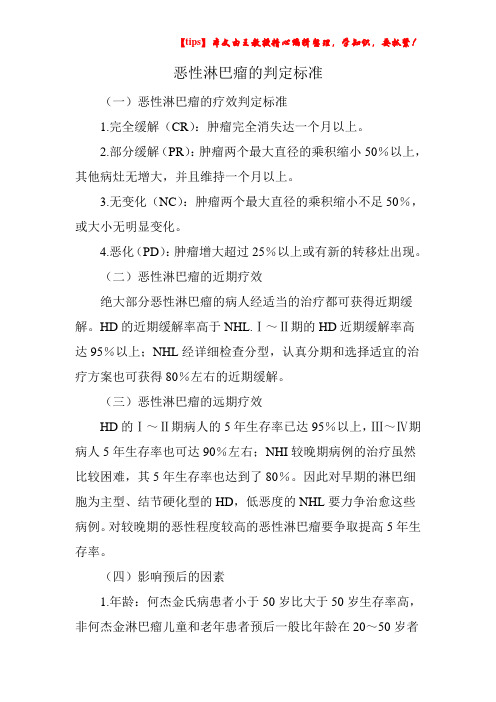
恶性淋巴瘤的判定标准(一)恶性淋巴瘤的疗效判定标准1.完全缓解(CR):肿瘤完全消失达一个月以上。
2.部分缓解(PR):肿瘤两个最大直径的乘积缩小50%以上,其他病灶无增大,并且维持一个月以上。
3.无变化(NC):肿瘤两个最大直径的乘积缩小不足50%,或大小无明显变化。
4.恶化(PD):肿瘤增大超过25%以上或有新的转移灶出现。
(二)恶性淋巴瘤的近期疗效绝大部分恶性淋巴瘤的病人经适当的治疗都可获得近期缓解。
HD的近期缓解率高于NHL.Ⅰ~Ⅱ期的HD近期缓解率高达95%以上;NHL经详细检查分型,认真分期和选择适宜的治疗方案也可获得80%左右的近期缓解。
(三)恶性淋巴瘤的远期疗效HD的Ⅰ~Ⅱ期病人的5年生存率已达95%以上,Ⅲ~Ⅳ期病人5年生存率也可达90%左右;NHI较晚期病例的治疗虽然比较困难,其5年生存率也达到了80%。
因此对早期的淋巴细胞为主型、结节硬化型的HD,低恶度的NHL要力争治愈这些病例。
对较晚期的恶性程度较高的恶性淋巴瘤要争取提高5年生存率。
(四)影响预后的因素1.年龄:何杰金氏病患者小于50岁比大于50岁生存率高,非何杰金淋巴瘤儿童和老年患者预后一般比年龄在20~50岁者差。
2.性别:在何杰金氏病患者中,女性治疗后生存率较高,而在非何杰金淋巴瘤中,男女预后无多大差别。
3.病理:何杰金氏病患者中,以淋巴细胞为主型预后最好,5年生存率为94.3%,结节硬化型和混合细胞型次之,而以淋巴细胞削减型预后最差,5年生存率仅27.4%。
非何杰金淋巴瘤中,滤泡型淋巴细胞分化好,6年生存率为61%;弥漫型淋巴细胞分化差,6年生存率为42%;淋巴母细胞型淋巴瘤,4年生存率为30%。
4.分期:何杰金氏病患者,Ⅰ期5年生存率为92.5%,Ⅱ期为86.3%,Ⅲ期为69.5%,EF期为31.9%。
5.全身症状:伴有全身症状的何杰金氏病患者预后比无全身症状者差,而对非何杰金淋巴瘤,全身症状对预后的影响较小。
恶性实体肿瘤的疗效评价标准
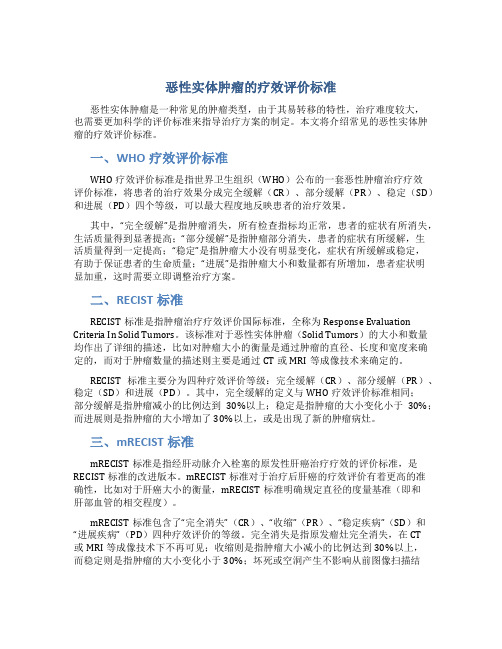
恶性实体肿瘤的疗效评价标准恶性实体肿瘤是一种常见的肿瘤类型,由于其易转移的特性,治疗难度较大,也需要更加科学的评价标准来指导治疗方案的制定。
本文将介绍常见的恶性实体肿瘤的疗效评价标准。
一、WHO疗效评价标准WHO疗效评价标准是指世界卫生组织(WHO)公布的一套恶性肿瘤治疗疗效评价标准,将患者的治疗效果分成完全缓解(CR)、部分缓解(PR)、稳定(SD)和进展(PD)四个等级,可以最大程度地反映患者的治疗效果。
其中,“完全缓解”是指肿瘤消失,所有检查指标均正常,患者的症状有所消失,生活质量得到显著提高;“部分缓解”是指肿瘤部分消失,患者的症状有所缓解,生活质量得到一定提高;“稳定”是指肿瘤大小没有明显变化,症状有所缓解或稳定,有助于保证患者的生命质量;“进展”是指肿瘤大小和数量都有所增加,患者症状明显加重,这时需要立即调整治疗方案。
二、RECIST标准RECIST标准是指肿瘤治疗疗效评价国际标准,全称为Response Evaluation Criteria In Solid Tumors。
该标准对于恶性实体肿瘤(Solid Tumors)的大小和数量均作出了详细的描述,比如对肿瘤大小的衡量是通过肿瘤的直径、长度和宽度来确定的,而对于肿瘤数量的描述则主要是通过CT或MRI等成像技术来确定的。
RECIST标准主要分为四种疗效评价等级:完全缓解(CR)、部分缓解(PR)、稳定(SD)和进展(PD)。
其中,完全缓解的定义与WHO疗效评价标准相同;部分缓解是指肿瘤减小的比例达到30%以上;稳定是指肿瘤的大小变化小于30%;而进展则是指肿瘤的大小增加了30%以上,或是出现了新的肿瘤病灶。
三、mRECIST标准mRECIST标准是指经肝动脉介入栓塞的原发性肝癌治疗疗效的评价标准,是RECIST标准的改进版本。
mRECIST标准对于治疗后肝癌的疗效评价有着更高的准确性,比如对于肝癌大小的衡量,mRECIST标准明确规定直径的度量基准(即和肝部血管的相交程度)。
边缘区淋巴瘤疗效评价标准
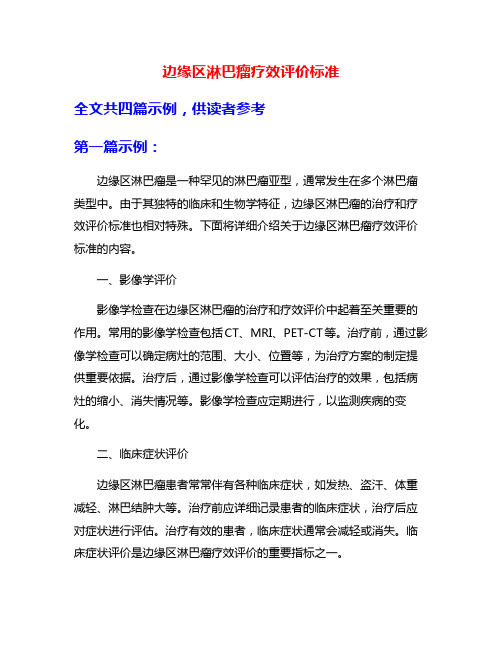
边缘区淋巴瘤疗效评价标准全文共四篇示例,供读者参考第一篇示例:边缘区淋巴瘤是一种罕见的淋巴瘤亚型,通常发生在多个淋巴瘤类型中。
由于其独特的临床和生物学特征,边缘区淋巴瘤的治疗和疗效评价标准也相对特殊。
下面将详细介绍关于边缘区淋巴瘤疗效评价标准的内容。
一、影像学评价影像学检查在边缘区淋巴瘤的治疗和疗效评价中起着至关重要的作用。
常用的影像学检查包括CT、MRI、PET-CT等。
治疗前,通过影像学检查可以确定病灶的范围、大小、位置等,为治疗方案的制定提供重要依据。
治疗后,通过影像学检查可以评估治疗的效果,包括病灶的缩小、消失情况等。
影像学检查应定期进行,以监测疾病的变化。
二、临床症状评价边缘区淋巴瘤患者常常伴有各种临床症状,如发热、盗汗、体重减轻、淋巴结肿大等。
治疗前应详细记录患者的临床症状,治疗后应对症状进行评估。
治疗有效的患者,临床症状通常会减轻或消失。
临床症状评价是边缘区淋巴瘤疗效评价的重要指标之一。
三、病理学评价病理学检查是确诊边缘区淋巴瘤的关键步骤,也是评估治疗效果的重要手段。
治疗前应对病理标本进行详细检查,包括淋巴结活检、骨髓穿刺等。
治疗后,通过再次检查病理标本,可以评估治疗的效果,如病灶的缩小、减轻、消失等。
病理学评价是边缘区淋巴瘤疗效评价的重要依据之一。
四、免疫学评价免疫学检测可以帮助判断患者的免疫功能状态,评估治疗的效果。
治疗前,通过检测免疫指标,可以了解患者的免疫功能状态,为治疗方案的选择提供依据。
治疗后,通过定期检测免疫指标,可以评估治疗的效果。
免疫学评价是边缘区淋巴瘤疗效评价的一个重要方面。
五、生活质量评价患者的生活质量对疗效评价也具有重要影响。
治疗前,应评估患者的生活质量,包括身体功能、精神状态、社会功能等方面。
治疗后,通过定期评估生活质量,可以了解治疗对患者的影响,评估治疗的效果。
生活质量评价是边缘区淋巴瘤疗效评价的一个重要方面。
边缘区淋巴瘤的治疗和疗效评价是一个综合性的过程,需要综合利用影像学、临床症状、病理学、免疫学、生活质量等多方面的指标进行评估。
恶性淋巴瘤疗效评价标准

Response Criteria for Lymphoma
Response Category CR CRu
PR
Relapse/ progression
Physical Examination
Normal
Lymph Nodes Lymph Node Masses
Normal
Normal
Bone Marrow Normal
> 75% decrease
Normal
≥50% decrease
≥50% decrease
New or increased
Normal or indeterminate Positive Irrelevant
Irrelevant
Reappearance
Definitions of End Points for Clinical Trials
2. immБайду номын сангаасnohistochemistry (IHC), 3. flow cytometry, 4. molecular biology
“REVISED RESPONSE CRITERIA FOR MALIGNANT LYMPHOMA”
J Clin Oncol 25:579-586. © 2007 by American Society of Clinical Oncology
Lymphoma
J Clin Oncol 25:571-578. © 2007 by American Society of Clinical Oncology
PET- PET/CT
• PET using [18F]fluorodeoxyglucose (FDG, a radioactive derivative of glucose, is an advanced imaging tool, based on the increased glucose consumption of cancer cells), has emerged as a powerful functional imaging tool for staging, restaging, and response assessment of lymphomas.
淋巴瘤协作组PR、CR、PD标准
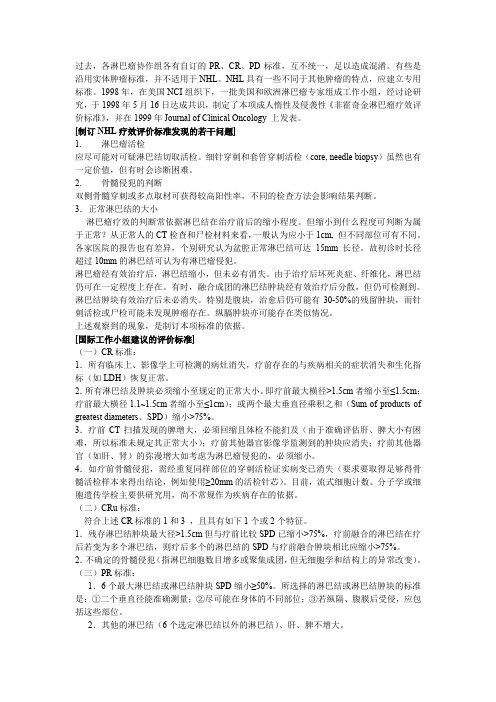
过去,各淋巴瘤协作组各有自订的PR、CR、PD标准,互不统一,足以造成混淆。
有些是沿用实体肿瘤标准,并不适用于NHL。
NHL具有一些不同于其他肿瘤的特点,应建立专用标准。
1998年,在美国NCI组织下,一批美国和欧洲淋巴瘤专家组成工作小组,经讨论研究,于1998年5月16日达成共识,制定了本项成人惰性及侵袭性《非霍奇金淋巴瘤疗效评价标准》,并在1999年Journal of Clinical Oncology 上发表。
[制订NHL疗效评价标准发现的若干问题]1. 淋巴瘤活检应尽可能对可疑淋巴结切取活检。
细针穿刺和套管穿刺活检(core, needle biopsy)虽然也有一定价值,但有时会诊断困难。
2. 骨髓侵犯的判断双侧骨髓穿刺或多点取材可获得较高阳性率,不同的检查方法会影响结果判断。
3.正常淋巴结的大小淋巴瘤疗效的判断常依据淋巴结在治疗前后的缩小程度。
但缩小到什么程度可判断为属于正常?从正常人的CT检查和尸检材料来看,一般认为应小于1cm, 但不同部位可有不同。
各家医院的报告也有差异,个别研究认为盆腔正常淋巴结可达15mm长径。
故初诊时长径超过10mm的淋巴结可认为有淋巴瘤侵犯。
淋巴瘤经有效治疗后,淋巴结缩小,但未必有消失。
由于治疗后坏死炎症、纤维化,淋巴结仍可在一定程度上存在。
有时,融合成团的淋巴结肿块经有效治疗后分散,但仍可检测到。
淋巴结肿块有效治疗后未必消失。
特别是腹块,治愈后仍可能有30-50%的残留肿块,而针刺活检或尸检可能未发现肿瘤存在。
纵膈肿块亦可能存在类似情况。
上述观察到的现象,是制订本项标准的依据。
[国际工作小组建议的评价标准](一)CR标准:1.所有临床上、影像学上可检测的病灶消失,疗前存在的与疾病相关的症状消失和生化指标(如LDH)恢复正常。
2.所有淋巴结及肿块必须缩小至规定的正常大小。
即疗前最大横径>1.5cm者缩小至≤1.5cm;疗前最大横径1.1~1.5cm者缩小至≤1cm);或两个最大垂直径乘积之和(Sum of products of greatest diameters、SPD)缩小>75%。
- 1、下载文档前请自行甄别文档内容的完整性,平台不提供额外的编辑、内容补充、找答案等附加服务。
- 2、"仅部分预览"的文档,不可在线预览部分如存在完整性等问题,可反馈申请退款(可完整预览的文档不适用该条件!)。
- 3、如文档侵犯您的权益,请联系客服反馈,我们会尽快为您处理(人工客服工作时间:9:00-18:30)。
PET
• False-positive: - Thymic hyperplasia - Infection - Inflammation - Sarcoidosis - Brown fat Other causes of false-positive scans should be ruled out.
• Allowing for comparisons among studies
• Facilitating the identification of more effective therapies
The widely used IWG criteria for response assessment of lymphoma are based predominantly on CT.
The Competence Network Malignant Lymphoma convened an International
Harmonization Project at which 5 subcommittees were formed:
• Response Criteria • End Points for Clinical Trials • Imaging • Clinical Features • Pathology/Biology
Use of Positron Emission Tomography for Response Assessment of Lymphoma: Consensus of the Imaging Subcommittee of International Harmonization Project in
Whole-body acquisition using a PET or PET/CT system should encompass at least the region between the base of the skull and themed thigh, and can be acquired in either two- or three-dimensional mode.
• The advantage of PET over conventional imaging techniques, such as TC or RMN, is its ability to distinguish between viable tumor and necrosis or fibrosis in residual mass(es) often present after treatment.
Response Criteria for Lymphoma
Response Category CR CRu
PR
Relapse/ progression
Physical Examination
Normal
Lymph Nodes Lymph Node Masses
Normal
Normal
Bone Marrow Normal
> 75% decrease
Normal
≥50% decrease
≥50% decrease
New or increased
Normal or indeterminate Positive Irrelevant
Irrelevant
Reappearance
Definitions of End Points for Clinical Trials
Normal
Normal
Normal
Indeterminate
Normal
Normal
Normal
Normal
Decrease in liver/spleen Enlarging liver/spleen; new sites
Normal
≥50% decrease ≥ 50% decrease
New or increased
“REVISED RESPONSE CRITERIA FOR MALIGNANT LYMPHOMA”
J Clin Oncol 25:579-586. © 2007 by American Society of Clinical Oncology
Cheson et al, J Clin Oncol 17:1244, 1999
In 1999, an International Working Group (IWG) of clinicians, radiologists, and pathologists with expertise in the evaluation and management of patients with Lymphoma published guidelines for response assessment and outcomes measurement.
Patients should have fasted for at least 4 hours before FDG injection.
Blood glucose level should not exceed 200 mg/dL at the time of FDG injection. If the blood glucose exceeds this level, the FDG-PET study should be rescheduled and an attempt made to control the blood sugar.
Lymphoma
J Clin Oncol 25:571-578. © 2007 by American Society of Clinical Oncology
PET- PET/CT
• PET using [18F]fluorodeoxyglucose (FDG, a radioactive derivative of glucose, is an advanced imaging tool, based on the increased glucose consumption of cancer cells), has emerged as a powerful functional imaging tool for staging, restaging, and response assessment of lymphomas.
It became clear that the International Working Group criteria warranted revision, because of identified limitations and the increased use of :
1. [18F] fluorodeoxyglucose-positron emission tomography (PET),
End Point Overall survival
Response Category
All patients
Event-free survival CR, CRu, PR
Progression-free survival
Disease-free survival
All patients CR, CRu
PET: 1. Increased the number of complete remission (CR)
patients, 2. Eliminated the CRu category 3. Enhanced the ability to discern the difference in
A recently developed integrated PET/CT system, which combines a PET camera and CT scanner in a single session, has overcome these drawbacks by providing both anatomical and functional imaging at the same position. PET/CT has become the new standard approach to imaging in the diagnosis and management of many cancer patients.
• False-negative: - Resolution of the equipment and technique - Variability of FDG avidity among histologic subtypes
Juweid et al. evaluated the impact of integrating PET into the IWG criteria in a retrospective study of 54 patients with diffuse large B-cell NHL who had been treated with an anthracycline-based regimen.
2. immunohistochemistry (IHC), 3. flow cytometry, 4. molecular biology
ห้องสมุดไป่ตู้
“REVISED RESPONSE CRITERIA FOR MALIGNANT LYMPHOMA”
J Clin Oncol 25:579-586. © 2007 by American Society of Clinical Oncology
Standardization of PET and CT Imaging Parameters
Patients undergoing PET imaging should receive an FDG dose of 3.5 to 8 MBq/kg of body weight, with a minimum dose of 185 MBq in adults (5 mCi) and 18.5 MBq (0.5 mCi) in children.
